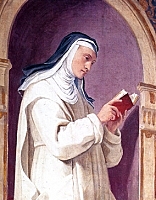Blessed Maaria the Holy
Princess Maaria of Shidåtudul (also called Blessed Maaria
the Holy, or sometimes Maaria Bruno) was the only daughter of Johan I, and
leader of the Ordre des Femmes Chartreuses, a holy order based in Plan-de-Baix,
France.
Born in 1740, she shared the same devout fascination of
Jesus as that of her grandfather, Adulf the Mad. From a very young age (some sources
say 2), she exhibited a deep understanding of the role of women in the bible
and in church. She was particularly taken with the stories of Esther and the
stories of Mary Magdalene.
When she came of age, she traveled to London to meet Thomas
Secker, the newly appointed Archbishop of Canterbury. Unfortunately, the
meeting did not meet Maaria’s expectations, as the Archbishop refused to see “a woman who likened herself to a prostitute”
(in reference to comments made by the princess earlier in the year about Mary
Magdalene).
Disgusted by this exchange, she embarked on a pilgrimage to
the birth site of St Bruno in Cologne. After 5 days of continual travel, she
arrived in Cologne, and immediately collapsed at the city gates. It was then
when she had one of her two epiphanies. According to her servant’s notes, the
princess explained that as she lay at the gate, St. Bruno came to her,
instructing her to create a women’s order of Carthusian nuns.
Once back in Whitmount after her travels, she instructed the
king to give her Ɍ250 (equivalent of Ɍ30,000 in today’s money) to build her monastery.
The king, famously a thrifty person, said yes, on the condition that it was out
of her allowance. She agreed, and then announced that her own allowance was to
be set aside for the poor girls of Whitmount (this money was instead used to fund
the Administration Division of the Shituthing).
Once she arrived in Plan-de-Baix, she founded a convent in
the town hall, and invited the local girls to join. She also sent out letters
to her royal friends, encouraging them to “lend
your service to community and to God”. Among her Femmes were Katrin
Yevdokiya Albertina, the granddaughter of Louis VI, Landgrave of
Hesse-Darmstadt, as well as Magda Apollonia of Saxony, daughter of Maria
Elisabeth of Saxony.
After 7 years, her convent was built. Each Femme had their own
little suite, with a bed upstairs, a writing desk and a crop box downstairs,
and a prayer alcove. Prayers (which lasted an hour) started at 6, followed by an
intense period of concentrer, where
the Femmes would spend up to 6 hours a day, in their rooms, either reading,
writing, illuminating manuscripts or tending to crops, to bring them closer to
God. At 1 o’clock, lunch would be served, which was sourced from the surrounding
land, as well as the Femmes own crop boxes. After lunch, the Femmes were
permitted 2 hours of open prayer and concentrer,
where by the previous activities were repeated, but this time in a social
setting, with the other nuns and lay sisters. Over time, the activities and
land widened to include helping the local girls become educated in writing and
music, as well as helping the local farmers at planting crops for winter.
In 1824, at aged 84, Maaria was in rapidly failing health,
and she gathered her Prioress’s to tell them what she wanted from the convent
in future times. Her final prediction, often called her second epiphany, was
said to predict the Durey Revolution, some 62 years later. This is taken from Prioress
Františka’s notes of the event;
Once Maaria Bruno had gathered
us by her bedside, she spoke with eloquence unbound; “I am telling you my last
will. In the next years, we shall see more turmoil than peace, but we will be
ready. My family, who have helped more than hindered, will now no longer help. The
people, with their wisdom, will tell us how to govern ourselves. But, sisters,
we must remember that we are governed by God, not by men. Do not listen to
them, listen to God.
I have one more
request; that I be buried with my Bible, in Église De Saint Pierre De Cherennes,
with an added 7 droplets of sea water placed in my hand, so I may cross the
long sea and meet myself, who you call Bruno.”
After this final
evocation, Marria told us that we should get back to prayers, only asking for
the oldest sister, Sister Colombe, to be by her side in her final moments. She died
during the night.

Comments
Post a Comment